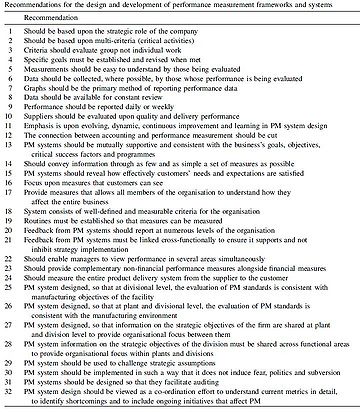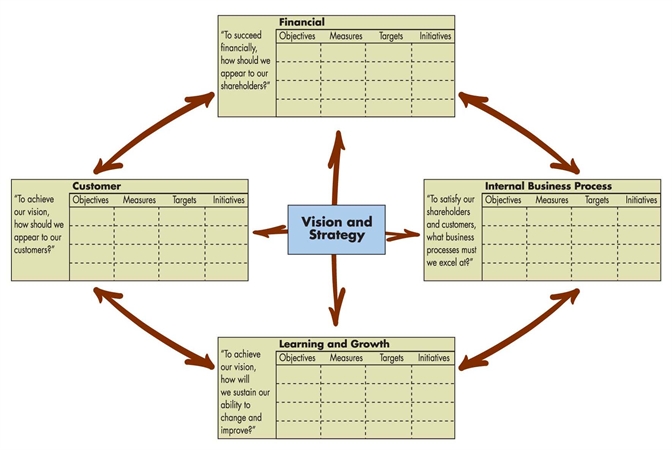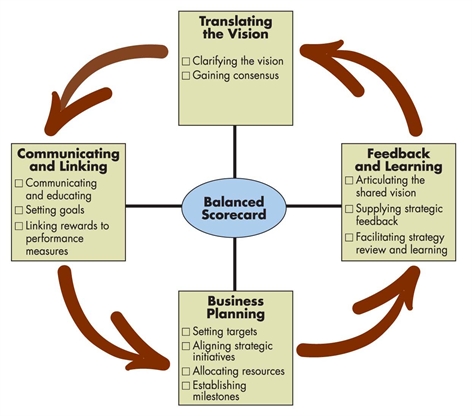Performance Measurement and Performance Management
(→Balanced Scorecard) |
(→Balanced Scorecard) |
||
| Line 79: | Line 79: | ||
The balanced scorecard framework is dynamic and should be updated to provide project managers with the information necessary to monitor and review the progress. | The balanced scorecard framework is dynamic and should be updated to provide project managers with the information necessary to monitor and review the progress. | ||
| + | |||
| + | [[File:Managing strategy.jpg|thumb|upright=6.0 |right| Figure 3 - The Balanced Scorecard operational framework [7]]] | ||
| + | |||
| + | Kaplan and Norton provide as well an additional framework: the procedural framework. This framework links long-term strategy with short-terms actions introducing four new management stages or processes [10]: | ||
| + | |||
| + | |||
| + | <ol style="list-style-type: lower-roman;"> | ||
| + | <li>The starting process is the Translating the Vision process. This stage intends to help managers clarifying and gaining consensus around a version of the organisation’s strategic vision that is operational upon all levels of a project or a firm. Lofty vision and strategy statements such as “making great the project” or “becoming number one supplier” are difficult to implement without a practical guide of operationality. Therefore, project managers must define the set of objectives and measures that describe the long-term drivers of success.</li> | ||
| + | |||
| + | |||
| + | <li>The second process is Communicating and Linking process. In this stage managers communicate their strategy up and down the organization. The purpose of this process is to communicate and link the strategy to individual and unit objectives. The balanced scorecard perspectives ensures that these objectives are linked to the long-term strategy.</li> | ||
| + | |||
| + | |||
| + | <li>The third stage is the Business Planning process. This process involves integrating business and financial plans to a project or an organisation. A correct definition and setting of measures enables setting priorities and allocating resources towards the long-term strategic objectives.</li> | ||
| + | |||
| + | |||
| + | <li>The fourth stage is the Feedback and Learning process. This process provides managers the capacity to learn from the performance. Managers gather feedback and measures that enables testing the hypotheses on which a strategy is based. Therefore managers can analyse and monitor performance on short-term results within the four perspectives (financial, customer, internal business and learning and growth) and make necessary adjustments on current strategies reflecting on real-time learning.</li> | ||
| + | </ol> | ||
===Business Process Reengineering (BPR) system=== | ===Business Process Reengineering (BPR) system=== | ||
Revision as of 13:32, 1 October 2017
Contents |
Introduction
Mathematical physicist and engineer Lord Kelvin introduced the notion of “an absolute zero” corresponding to the absolute absence of thermal agitation. The Kelvin scale, named after him, is the scale of the base unit of temperature measurement used in the International System of Units. He has not only impacted the field of thermodynamics but also influenced investigation.
“If you can not measure it, you can not improve it”. This quote by Lord Kelvin highlights the importance of measurement. Measurement in management is essential for continuous improvement. Despite the importance of measurement, taking measurements in project management is not as frequent as it should be. A project can be interpreted from different angles, which leads to the importance of the project manager. It comes to the project manager to set goals, make decisions, stablish the key indicators and parameters to control and monitor the progress of a particular project. Performance measurements must be defined to monitor and, therefore, manage projects to thrive in an organizational context.
This article intends to serve as a guide for future project management practitioners.
Big Idea of Performance Measurement and Management
Performance is defined as the execution of an action [1]. Every action has an impact and the embedded curiosity of humans impels us to analyze, qualitatively or quantitatively, the magnitude of that impact. In a Project management context, analysis entails a successful or unsuccessful management of projects.
In order to analyze, measurements must be made in advance. The definition of goals is the most arduous stage of the measurement process. Sink stated that measurement is a mystery, admitting that is complex, frustrating, difficult, challenging, important, abused and misused [2].
Performance measurement systems are developed in order to monitor and maintain organizational control. This process ensures that an organization pursues strategies that lead to the achievement of overall goals and objectives [3]. The performance measurement is the quantification of the results achieved in relation to the desired goal. The overall performance of an organization is based on social, financial, economic and environment performance and affects the organization’s reputation, meet of expectations and ability to attract and withholding of stakeholders. Although small businesses may be able to operate without setting and measuring goals despite the benefits of this tools, medium-sized businesses and large organizations find this control of processes critical.
Therefore, performance measurement is a powerful tool to achieve a more effective management. Nevertheless, measurements in performance only provides indications about an effect, about what happened. The outcome of these measurements do not provide information about the cause of that result nor what to do about it [4]. Thus, performance management uses performance measurement to refine organizational activities.
Application
Performance measurement offers a framework of results that will be managed and evaluated to improve the operations of an organization in order to align its objective. Therefore, performance measurement forms the basis of organizational management and triggers the possibility to assess the progress towards the organization's defined objectives.
According to Bititcti et al, performance measurement needs to include the following characteristics [5]:
- being sensitive to changes that can occur in an organization's external and internal environment;
- when the changes in the external and internal environment are significant enough, review and reprioritize internal objectives;
- deploying the changes to internal objectives and priorities to critical parts of the organization, thus ensuring alignment at all times;
- ensuring that gains achieved through improvement programmes are maintained.
A way to measure objectives of projects and project management are the Key Performance Indicators (KPI). The setting of KPIs need to be comprehensive and balanced as will define the procedure of measurement and its subsequent analysis. Consequently, the SMART goal setting technique is recommended due to its specificity, measurability, achievability relevancy and time feasibility facilitating the ability to learn from the performance indicators and use them in the performance management analysis. Paul Folan and Jim Browne grouped together different recommendations on designing of performance measurement frameworks and systems proposed by various researches in the field such as [6]:
- performance measurements should be based upon the strategic role of the company;
- measurements should be easy to understand by those being evaluated;
- emphasis is upon evolving, dynamic, continuous improvement and learning of performance measurements system design;
- performance measurement should convey information through as few and as simple a set of measures as possible
- performance measurement should provide complementary non-financial performance measures alongside financial measures;
- performance measurement should measure the entire product delivery system from the supplier to the customer.
When assessing the results of the measurements, three performance measurements systems are the most representative: the Balanced Scorecard system, the Business Process Reengineering system and the Medori and Steeple's system [6].
Balanced Scorecard
The Balanced Scorecard prioritizes strategy and vision while considering control and promoting a comprehensive view of a project or an organization. The use of this tool may comprise objectives such as aligning processes with a project or getting consensus around a strategy. An approach to assessing performance is illustrated considering an extensive range of factors. The balanced scorecard framework is based on a combination of four perspectives encircling vision and strategy: financial, customer, internal business, and learning and growth perspectives.
The balanced scorecard allows tracking financial results while monitoring progress in building the capabilities needed for growth. The framework template is represented in Figure 2. In each perspective, an objective is set by the specification of measures to take. The objective must be defined with a target and initiatives are proposed to achieve this target [10]:
- The Financial perspective concentrates on helping managers track financial success in terms of measurable variables such as operating costs, return on investment, generation of cash flow or shareholder value.
- The Customer perspective fixates on helping managers to consider customer objectives and how is the appearance to customers. This perspective can be measured in terms of indexes of customer satisfaction, customer acquisition, market share or on-time delivery.
- The Internal Business Process perspective focuses attention on helping managers concentrating on operational goals and on the key processes in need to deliver customer objectives and satisfy shareholders. This perspective can be measured in terms of quality of processes, cycle time of processes or inventory control.
- The Learning and Growth perspective establishes attention on the intangible assets of future success such as employee skills, leadership, technology training, information availability or organizational culture.
The balanced scorecard framework is dynamic and should be updated to provide project managers with the information necessary to monitor and review the progress.
Kaplan and Norton provide as well an additional framework: the procedural framework. This framework links long-term strategy with short-terms actions introducing four new management stages or processes [10]:
- The starting process is the Translating the Vision process. This stage intends to help managers clarifying and gaining consensus around a version of the organisation’s strategic vision that is operational upon all levels of a project or a firm. Lofty vision and strategy statements such as “making great the project” or “becoming number one supplier” are difficult to implement without a practical guide of operationality. Therefore, project managers must define the set of objectives and measures that describe the long-term drivers of success.
- The second process is Communicating and Linking process. In this stage managers communicate their strategy up and down the organization. The purpose of this process is to communicate and link the strategy to individual and unit objectives. The balanced scorecard perspectives ensures that these objectives are linked to the long-term strategy.
- The third stage is the Business Planning process. This process involves integrating business and financial plans to a project or an organisation. A correct definition and setting of measures enables setting priorities and allocating resources towards the long-term strategic objectives.
- The fourth stage is the Feedback and Learning process. This process provides managers the capacity to learn from the performance. Managers gather feedback and measures that enables testing the hypotheses on which a strategy is based. Therefore managers can analyse and monitor performance on short-term results within the four perspectives (financial, customer, internal business and learning and growth) and make necessary adjustments on current strategies reflecting on real-time learning.
Business Process Reengineering (BPR) system
Medori and Steeple's system
Annotated Bibliography
[1] Definition of PERFORMANCE. (2017). Merriam-webster.com. Retrieved 22 September 2017, from https://www.merriam-webster.com/dictionary/performance
[2] Sink, D. (1991), “The role of measurement in achieving worl class quality and productivity management”, Industrial Engineering, Vol. 23 No. 6.
[3] Nani et al (1990), “Strategic control and performance measurement”, Journal of Cost Management, Summer, pp. 33-42.
[4] Amaratunga, D. and Baldry, D. (2002) “Moving from performance measurement to performance management”, Facilities, Vol. 20 Issue: 5/6, pp.271-223.
[5] Bititcti, U.S., Turner, T. and Begermann, C. (2000) "Dynamics of performance measurement systems", International Journal of Operations and Production Management, Vol.20 No. 6, pp.682-704.
[6] Folan, P. and Browne, J (2004) "A review of performance measurement: Towards performance management", Computers in Industry, Vol. 56 Issue: 7, pp.663-680.

